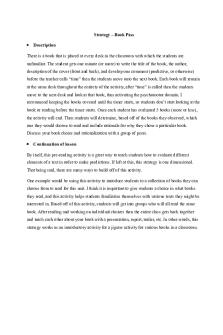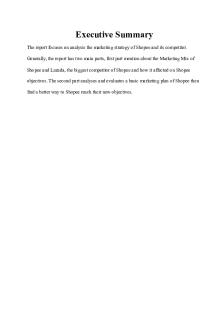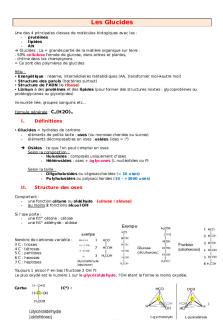LAB Report 11 - Frequency Response of High Pass Low Pass RC RL Circuits PDF

| Title | LAB Report 11 - Frequency Response of High Pass Low Pass RC RL Circuits |
|---|---|
| Author | Orochinagi __ |
| Course | Electric Circuits Analysis II |
| Institution | COMSATS University Islamabad |
| Pages | 27 |
| File Size | 2.3 MB |
| File Type | |
| Total Downloads | 93 |
| Total Views | 150 |
Summary
Frequency Response of High Pass Low Pass RC RL Circuits...
Description
LAB REPORT#11 SUBJECT: EEE222 ECA II INSTRUCTOR: SYED BILAL JAVED SUBMITTED BY: UMAIR AHMAD
REGISTRATION: FA18-BEE-155
COMSATS UNIVERSITY ISLAMABAD (CUI)
COMSATS University Islamabad Department of Electrical and Computer Engineering Lab 11 ECA II
Name: ______UMAIR AHMAD____
Reg. No: ______FA18-BEE-155____
•
To design RC low pass & high pass filter circuit with cutoff frequency of 155 KHZ, also draw a frequency response theoretically on semi-log plots: (a) magnitude response (b) phase response.
•
To design RL low pass & high pass filter circuit with cutoff frequency of 155 KHZ,, also draw a frequency response theoretically on semi-log plots: (a) magnitude response (b) phase response.
RC Low/High Pass Filter RC Low / High Pass Filter: The cutoff frequency of a RC low / high pass filter is:
𝑐 =
1
𝑅𝐶
Taking the value of capacitor C = 10uF and fc = 155 KHz, we get: 𝑅= 𝑅=
1
𝐶
1
2 (155×103 )(10×10−6 )
𝑅 = 102 .681 𝑚
RC Low Pass Filter: So our required circuit is:
The magnitude transfer function and phase of RC Low-Pass filter circuit is:
|H(ω)| =
1
√1+(𝜔𝑅𝐶)2
= − tan−1 ( 𝑅𝐶)
For R=102.681m, C=10uF we have:
Bode Plot:
ω
|H(ω)| (dB)
ω =0
20log(1)=0
0
ω =∞
20log(0)
-90
ω = ωc = 2*155Khz
20log(1/√2)
-45
RC High Pass Filter: Our required circuit is:
The magnitude transfer function and phase of RC High-Pass filter circuit is:
|H(ω)| =
𝑅
2
√ 2+( 1 ) 𝜔𝐶 𝑅
= 90 − tan−1( 𝑅𝐶)
For R=102.681m, C=10uF we have: ω
|H(ω)| (dB)
ω =0
20log(0)
90
ω =∞
20log(1)
0
20log(1/√2)
45
ω = ωc = 2*155Khz Bode Plot:
RL Low/High Pass Filter RL Low / High Pass Filter: The cutoff frequency of a RL low / high pass filter is:
𝑐 =
𝑅
𝐿
Taking the value of inductor as L = 1mH and fc = 155 KHz, we get: 𝑅 = 𝐶 𝐿
𝑅 = 2 (155 × 103 )(1 × 10−3 ) 𝑅 = 973.9
RL Low Pass Filter: So our required circuit is:
The magnitude transfer function and phase of RL Low-Pass filter circuit is:
|H(ω)| =
𝑅
√𝑅 2 +(𝜔𝐿) 2
𝐿
= − tan−1 ( ) 𝑅
For R=973.9, L=1mH we have:
Bode Plot:
ω
|H(ω)| (dB)
ω =0
20log(1)=0
0
ω =∞
20log(0)
-90
ω = ωc = 2*155Khz
20log(1/√2)
-45
RL High Pass Filter: Our required circuit is:
The magnitude transfer function and phase of RL High-Pass filter circuit is: 𝐿 = 90 − tan−1 ( 𝑅 ) |H(ω)| = 2 𝑅 √ 2 +( ) 𝐿 For R=973.9, L=1mH we have:
Bode Plot:
ω
|H(ω)| (dB)
ω =0
20log(0)
90
ω =∞
20log(1)
0
ω = ωc = 2*155Khz
20log(1/√2)
45
RC Low Pass Filter R1 Vin V1
Vout
102.681m
C1 10µF
AC 5 .ac dec 50 1KHz 500KHz --- C:\Users\Useless Noob\Documents\Umair\Sem 5th\ECA 2\LAB\Lab 11\Pre Lab.asc ---
V(vout)/V(vin)
We observe that at cutoff phase is equal to -44.98 deg which is
154.95959KHz,
apporximatley equal to our theoretical results
V(vout)/V(vin)
0.98
0.91 5.4068849KHz,999.39184m
0.84
Fc =
154.95959KHz,707.24435m
0.77
0.70 Here we observe that at the cutoff frequency Fc, magnitude is 70.7% of the maximumm gain (1)
0.63
0.56
0.49
Also for frequecy lower than cutoff, gain aproches max value and for values greater than cutoff,
Gain aproaches zero, which matches with our theoretical results.
0.42
0.35
0.28 1KHz
Pass Band
10KHz 100KHz --- C:\Users\Useless Noob\Documents\Umair\Sem 5th\ECA 2\LAB\Lab 11\Pre Lab.raw ---
RC HighPass Filter C1 Vin
Vout
10µF
V1
R1 102.681m AC 5 .ac dec 50 1KHz 500KHz
--- C:\Users\Useless Noob\Documents\Umair\Sem 5th\ECA 2\LAB\Lab 11\Pre Lab.asc ---
V(vout)/V(vin)
155.19492KHz
We observe that at cutoff phase is equal to 44.98 deg which is apporximatley equal to our theoretical results
V(vout)/V(vin)
990m
900m
Stop Band
810m
720m Fc =
155.19492KHz,707.41275m
630m
540m
450m Here we observe that at the cutoff frequency Fc, magnitude is 70.7% of the maximumm gain (1)
360m Also for frequecy lower than cutoff, gain aproches zero and for values greater than cutoff,
270m Gain aproaches max value 1, which matches with our theoretical results.
180m 90m 0m 1KHz
10KHz 100KHz --- C:\Users\Useless Noob\Documents\Umair\Sem 5th\ECA 2\LAB\Lab 11\Pre Lab ---
RL Low Pass Filter L1 Vin V1
Vout
1mH R1 973.9
AC 5 .ac dec 50 1KHz 500KHz --- C:\Users\Useless Noob\Documents\Umair\Sem 5th\ECA 2\LAB\Lab 11\Pre Lab.asc ---
V(vout)/V(vin)
154.95959KHz We observe that at cutoff phase is equal to -44.98 deg which is
apporximatley equal to our theoretical results
V(vout)/V(vin)
0.98
0.91
0.84
0.77 Here we observe that at the cutoff frequency Fc, magnitude is 70.7% of the maximumm gain (1)
0.70 Also for frequecy lower than cutoff, gain aproches max value 1 and for values greater than cutoff,
0.63
0.56
Gain aproaches zero, which matches with our theoretical results.
Fc =
154.95959KHz,707.24761m
0.49
0.42
0.35
0.28 1KHz
Pass Band
10KHz 100KHz --- C:\Users\Useless Noob\Documents\Umair\Sem 5th\ECA 2\LAB\Lab 11\Pre Lab ---
RL High Pass Filter R1 Vin V1
Vout
973.9 L1
AC 5 .ac dec 50 1KHz 500KHz --- C:\Users\Useless Noob\Documents\Umair\Sem 5th\ECA 2\LAB\Lab 11\Pre Lab.asc ---
1mH
V(vout)/V(vin)
155.19492KHz
We observe that at cutoff phase is equal to 44.97 deg which is apporximatley equal to our theoretical results
V(vout)/V(vin)
990m
900m Stop Band
810m
720m
630m
540m Here we observe that at the cutoff frequency Fc, magnitude is 70.7% of the maximumm gain (1)
450m Also for frequecy lower than cutoff, gain aproches zero and for values greater than cutoff,
360m Gain aproaches max value 1, which matches with our theoretical results.
270m
180m 90m 0m 1KHz
10KHz 100KHz --- C:\Users\Useless Noob\Documents\Umair\Sem 5th\ECA 2\LAB\Lab 11\Pre Lab ---
Fc
Post Lab 1)
Why are capacitors preferred over inductors in filter design?
The basic reason is physical and economical. In electronics, all the parts should be as small as possible. An average capacitor is much smaller and cheaper as compared to that of an inductor. Moreover manufacturing of an inductor having tolerance less than 10% is very difficult and its inductance may vary due to stray-magnetic field in the surroundings. whereas a capacitor can be manufactured of specific value having very much less tolerance. Inductors are very hard to realize in IC circuits and occupy a very large area. A capacitor on the other hand can be realized using a varactor diode, MOS based capacitors etc.
2)
Create Bode plots of the magnitude transfer functions of your low-pass and high-pass filters. The theoretical plots (using measured values of resistors and capacitors) should be drawn as lines. Include your data (taken at 1/10, ½, 1, 2, and 10 times the cutoff frequency) as points.
RC Low/High Pass Filter The magnitude transfer function and phase of RC Low-Pass filter circuit is:
|H(ω)| =
1
√1+(𝜔𝑅𝐶)2
= − tan−1 ( 𝑅𝐶)
ω
|H(ω)| (dB)
ω =0
20log(1)=0
0
ω =∞
20log(0)
-90
ω = ωc = 2*155Khz
20log(1/√2)
-45
The magnitude transfer function and phase of RC High-Pass filter circuit is:
|H(ω)| =
𝑅
2
√ 2+( 1 ) 𝜔𝐶 𝑅
= 90 − tan−1( 𝑅𝐶)
ω
|H(ω)| (dB)
ω =0
20log(0)
90
ω =∞
20log(1)
0
ω = ωc = 2*155Khz
20log(1/√2)
45
Fc = 155KHz: The cutoff frequency of a RC low / high pass filter is:
𝑐 =
1
𝑅𝐶
Taking the value of capacitor C = 10uF and fc = 155 KHz, we get: 𝑅= 𝑅=
1
𝐶
1 2 (155×103 )(10×10−6 )
𝑅 = 102 .681 𝑚
RC Low Pass Filter: So our required circuit is:
RC High Pass Filter: Our required circuit is:
Fc = 155/10 = 15.5KHz: The cutoff frequency of a RC low / high pass filter is:
𝑐 =
1
𝑅𝐶
Taking the value of capacitor C = 10uF and fc = (155)/10 = 15.5 KHz, we get: 𝑅= 𝑅=
1
𝐶
1 2 (15.5×103 )(10×10−6 )
𝑅 = 1026 .81 𝑚
RC Low Pass Filter: So our required circuit is:
RC High Pass Filter: Our required circuit is:
Fc = 155/2 = 77.5KHz: The cutoff frequency of a RC low / high pass filter is:
𝑐 =
1
𝑅𝐶
Taking the value of capacitor C = 10uF and fc = (155)/2 = 77.5 KHz, we get: 𝑅= 𝑅=
1
𝐶
1 2 (77.5×103 )(10×10−6 )
𝑅 = 205 .36 𝑚
RC Low Pass Filter: So our required circuit is:
RC High Pass Filter: Our required circuit is:
Fc = 155*2 = 310 KHz: The cutoff frequency of a RC low / high pass filter is:
𝑐 =
1
𝑅𝐶
Taking the value of capacitor C = 10uF and fc = (155)*2 = 310 KHz, we get: 𝑅= 𝑅=
1
𝐶
1
2 (310×103 )(10×10−6 )
𝑅 = 51 .34 𝑚
RC Low Pass Filter: So our required circuit is:
RC High Pass Filter: Our required circuit is:
Fc = 155*10 = 1550 KHz: The cutoff frequency of a RC low / high pass filter is:
𝑐 =
1
𝑅𝐶
Taking the value of capacitor C = 10uF and fc = (155)*10 = 1550 KHz, we get: 𝑅= 𝑅=
1
𝐶
1 2 (1550×103 )(10×10−6 )
𝑅 = 10 .2681 𝑚
RC Low Pass Filter: So our required circuit is:
RC High Pass Filter: Our required circuit is:
3)
Compare the measured results and simulation results.
We observe from question 2 that our theoretical results and simulation results are exactly equal. In case of Low Pass Filter we observe that for frequencies lower than cutoff gain magnitude is closer to 1, whereas for increasing frequencies it approaches zero and vice versa in the case of High Pass Filter.
Critical Analysis: This lab involved designing Low Pass and High Pass RC and RL circuits. Their response was also determined theoretically and the were compared with the simulated response of the circuits....
Similar Free PDFs

RC circuits - lab report
- 4 Pages

Lab RC circuits /lab
- 14 Pages

Lab 7 RC Circuits - lab report
- 6 Pages

Lab 1: Basic RL and RC DC Circuits
- 32 Pages

Pass week 7 - Pass class week 7
- 2 Pages

W04P - pass
- 6 Pages

Strategy Dem Book Pass
- 4 Pages

Educonnect pass Culture Individuel
- 17 Pages

Shopee-pass - Grade: B
- 23 Pages

Les glucides - biochimie PASS
- 5 Pages
Popular Institutions
- Tinajero National High School - Annex
- Politeknik Caltex Riau
- Yokohama City University
- SGT University
- University of Al-Qadisiyah
- Divine Word College of Vigan
- Techniek College Rotterdam
- Universidade de Santiago
- Universiti Teknologi MARA Cawangan Johor Kampus Pasir Gudang
- Poltekkes Kemenkes Yogyakarta
- Baguio City National High School
- Colegio san marcos
- preparatoria uno
- Centro de Bachillerato Tecnológico Industrial y de Servicios No. 107
- Dalian Maritime University
- Quang Trung Secondary School
- Colegio Tecnológico en Informática
- Corporación Regional de Educación Superior
- Grupo CEDVA
- Dar Al Uloom University
- Centro de Estudios Preuniversitarios de la Universidad Nacional de Ingeniería
- 上智大学
- Aakash International School, Nuna Majara
- San Felipe Neri Catholic School
- Kang Chiao International School - New Taipei City
- Misamis Occidental National High School
- Institución Educativa Escuela Normal Juan Ladrilleros
- Kolehiyo ng Pantukan
- Batanes State College
- Instituto Continental
- Sekolah Menengah Kejuruan Kesehatan Kaltara (Tarakan)
- Colegio de La Inmaculada Concepcion - Cebu





